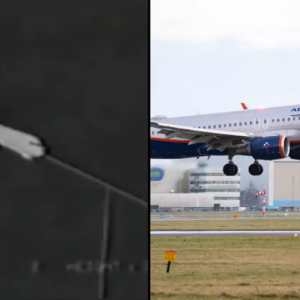The 7th Panzer Division: Germany’s Ghost Division
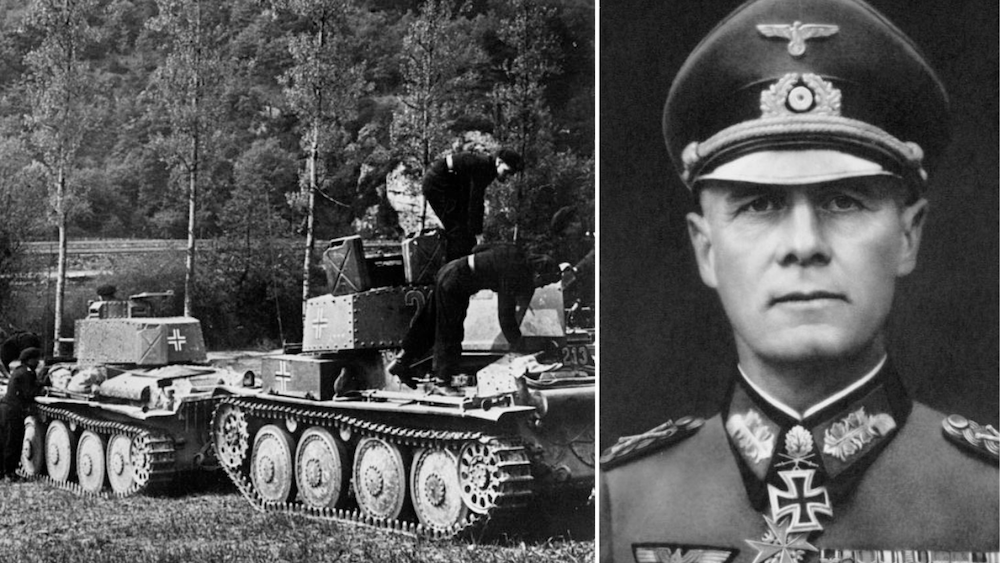
×
The German invasion of France during the middle of 1940 was swift and effective. Within a matter of months, they’d overrun the country’s defenses and were well on their way to conquering other European countries. One of the reasons for their success was the 7th Panzer Division, also known as the Ghost Division.
The 7th Panzer Division is born
After the invasion of Poland, the 2nd Light Division was renamed the 7th Panzer Division. One of the German Army’s 10 armored divisions, it was made up of 218 tanks in three divisions two rifle regiments, an engineer battalion, an antitank battalion, and a motorcycle battalion.
In February 1940, Major General Erwin Rommel was named its commander. This was against the opinion of the chief of Army personnel, who’d recommended he be given command of a mountain division. Rommel had no experience with Germany’s new blitzkrieg operations and had never commanded his own division. This has led many to speculate he used his ties to Hitler to obtain the position.
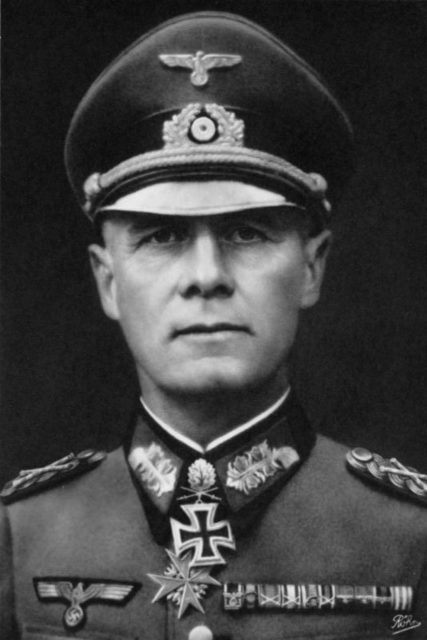
Erwin Rommel. (Photo Credit: Unknown Author / Wikimedia Commons CC BY-SA 3.0 DE)
The division was highly regarded in German political circles. Joseph Goebbels, chief propagandist for the Nazi Party, thought highly of Rommel, and many saw the 7th Panzer Division as part of the country’s propaganda machine. This was due to many of its members holding ties to anti-semitic organizations.
Read also: Reviewed: The Last British Battleship
Invasion of France
The 7th Panzer Division’s first foray into the war would be the German invasion of France. Codenamed Fall Gelb, the Nazis assembled 135 divisions, including their 10 panzer units. Rommel’s served as the center of the XV Panzer Corps, commanded by Field Marshal Günther von Kluge.
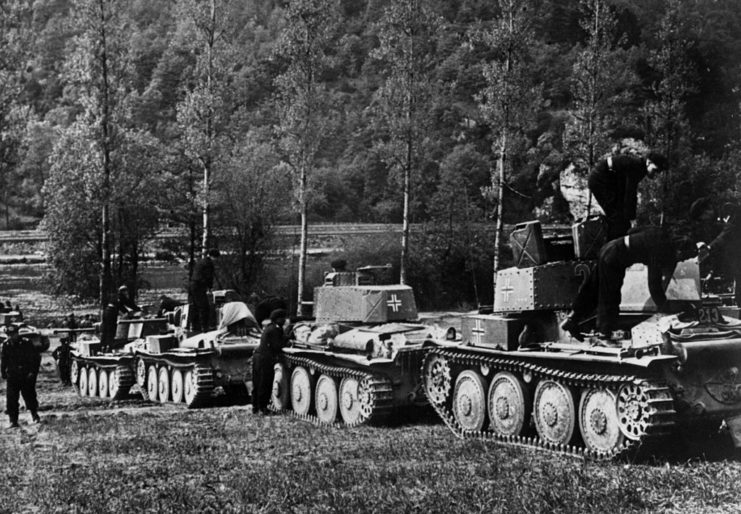
German tanks waiting to cross the Meuse River. (Photo Credit: Mondadori Portfolio / Getty Images)
On May 10, 1940, the division crossed the border between Germany and Belgium, with the objective of crossing the Meuse River. They experienced little resistance, as the bulk of the Belgian Army was stationed to the north to defend the larger cities.
Read also: Reviewed: Spitfire! The Full Story of a Unique Battle of Britain Fighter Squadron
The division met its first major opposition at Chabrehez, but that didn’t stop Rommel’s advance. By the end of the second day, they’d advanced 40 miles, with another 18 covered the following day. Despite the French Army having bolstered its forces, Rommel was able to capture the bridge crossing at the Meuse by the end of May 12, 1940.
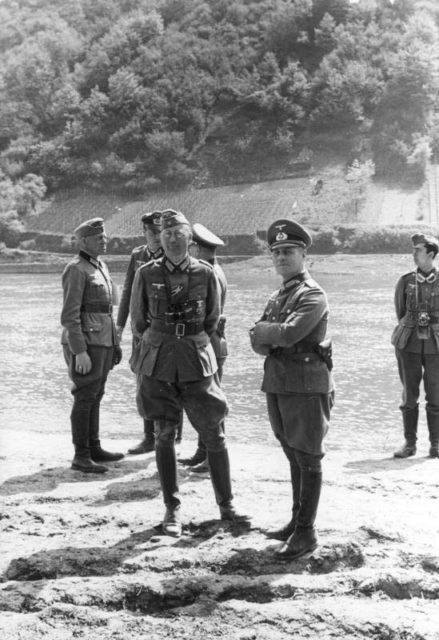
Rommel and staff observing the 7th Panzer Division practicing a river crossing. (Photo Credit: Gutjahr / Wikimedia Commons CC BY-SA 3.0 DE)
While there were some setbacks, including the “Onhaye crisis,” Rommel and the German Army continued to see success as they crossed France. A main reason for this was Rommel’s favoring of night attacks, which allowed them to strike while much of the French forces were unaware.
Read also: The British German Reenactor Who Applied for the Role as The Napoleon Impersonator
One example of this was the 7th Panzer Division’s attack on the Maginot Line extension. Rommel breached it by the end of May 16, 1940, destroying the French Ninth Army and its XI and II Corps in the process. It was deemed “the most spectacular German exploit of the day” by author Alistair Horne.
British counterattack
Hoping to stop the German advancement in France, Prime Minister Winston Churchill charged Major General Giffard le Quesne Martel, commander of the British 50th Infantry Division, with launching a counterattack.
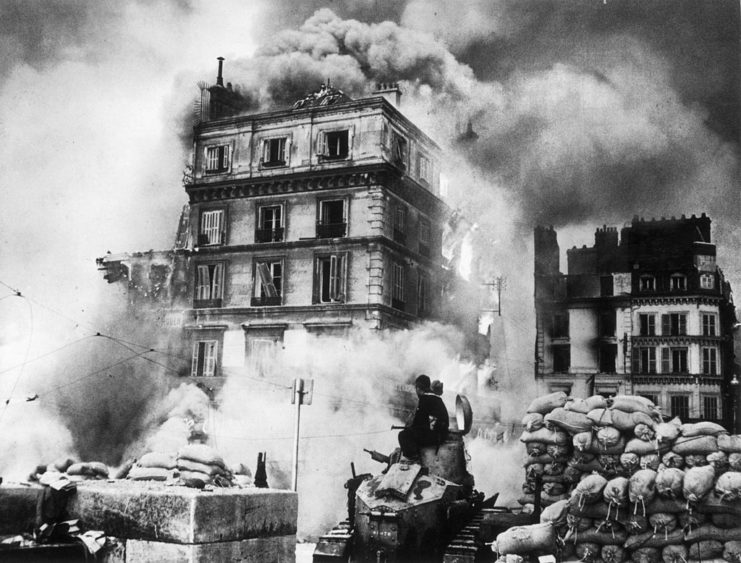
Rouen on fire during the invasion of France, 1940. (Photo Credit: Hulton Archives / Getty Images)
Martel planned for two mobile columns to be the main part of his force. It consisted of a tank battalion, infantry from the 151st Brigade, a battery of field artillery, reconnaissance motorcycles, and a battery of antitank guns. The French assisted in a limited capacity, offering 60 tanks to join the 58 Mark I and 16 Mark II tanks the British enlisted.
Read also: The Official Trailer of ‘Jojo Rabbit’ Is It Uncomfortable Satire?
The 7th Panzer Division met the British Army’s 6th Motorized Infantry Regiment on May 21, 1940. In Rommel’s opinion, only heavy fire would get them out of the situation. By the end, the division had suffered countless casualties and equipment losses, as had the British.
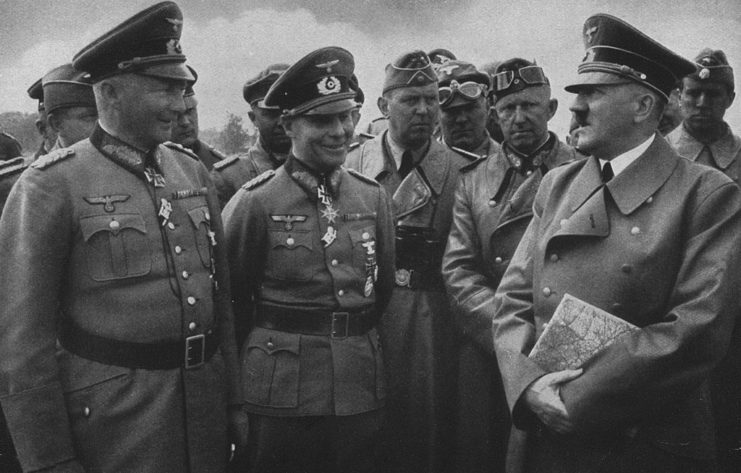
Hitler meeting with Rommel and von Kluge, 1940. (Photo Credit: Hulton Archive / Getty Images)
The attack slowed the division, but it didn’t stop them from traveling north. They continued in the days following the attack, taking siege of Lille and breaching the French line at the Somme River.
Read also: Reviewed: The Little Bighorn Campaign 1876-77
Praise for the 7th Panzer Division
When the armistice between France and Germany came into effect on June 25, 1940, the 7th Panzer Division was 200 miles from the Spanish frontier. It was put on reserve and sent to the Somme before traveling to Bordeaux to re-equip for the German invasion of Britain. Codenamed Unternehmen Seelöwe, it was eventually called off.
The German campaign in France was deemed “the greatest battle of annihilation of all time” by many. Despite having access to less equipment and military personnel than the French and the Belgians, the German Army had swiftly taken control.
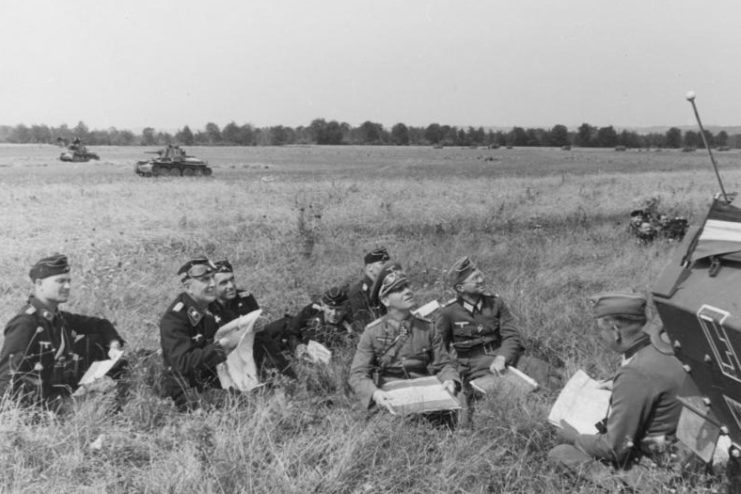
Rommel and staff during the Battle for France, June 1940. (Photo Credit: Unknown Author / Wikimedia Commons CC BY-SA 3.0 DE)
The speed at which the 7th Panzer Division was able to achieve success earned them the nickname Gespensterdivision, or Ghost Division. The exploits also delighted Rommel’s benefactors and assured his advancement in the German Army.
Read also: In 1943 a Soldier Found D-Day Invasion Plans & Kept it a Secret
To help drive home the German Army’s success, Rommel helped Goebbels produce the propaganda film, Victory in the West. He later published the war diary of the 7th Panzer Division, which was gifted to Hitler by his friend, Rudolf Schmundt.
Ghost Division during Operation Barbarossa
In February 1941, the 7th Panzer Division returned to Germany, where General Hans von Funck assumed control. Rommel had been promoted to lieutenant general and sent to Libya to command the Afrika Korps during Operation Sonnenblume.
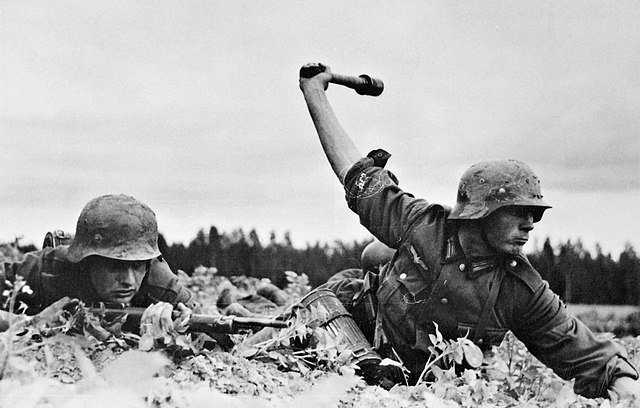
German troops in Russia, 1941. (Photo Credit: Unknown Author / Wikimedia Commons)
Eventually, the division was stationed near Bonn while preparations were made to invade the Soviet Union. The mission was codenamed Operation Barbarossa. They remained there until June 8, 1941, after which they assembled in east Prussia.
Read also: Wanted: Napoleon Impersonator Required on Island of St Helena
The invasion began on June 22, 1941, and proceeded quickly. Russian resistance was weaker than expected, allowing the division to cover a lot of land in a small period of time. They were eventually slowed after a series of Soviet-initiated counterattacks, but were able to fend them off after reinforcements from the 20th Panzer Division arrived.
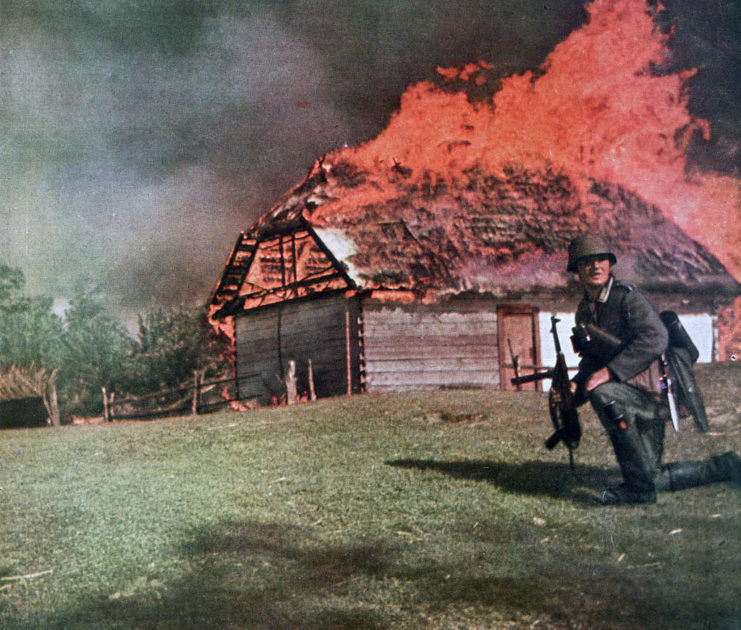
German soldier during Operation Barbarossa. (Photo Credit: Print Collector / Getty Images)
Over the next month, the division joined up with other panzer divisions. They took control of Russian towns, as the Red Army was unable to mount a proper linear defense. While there were pockets of resistance, the Germans easily defeated them. Come the middle of July, the 7th Panzer Division was relieved by infantry divisions.
Read also: Medal of Nazi Bodyguard Who Took Six Bullets For Adolf is Sold at Auction
Return to the Eastern Front
After participating in a number of battles against the Soviets, the unit was transferred to France in May 1942. Still under the command of von Funck, they were tasked with coastal protection duties with the 1st Army.
On November 11, 1942, they were sent to the Mediterranean coast between Perpignan and Narbonne. As Hitler feared a continental Allied invasion, preparations were being made to seize the Vichy fleet at Toulon. The mission was codenamed Operation Lila and ultimately failed.
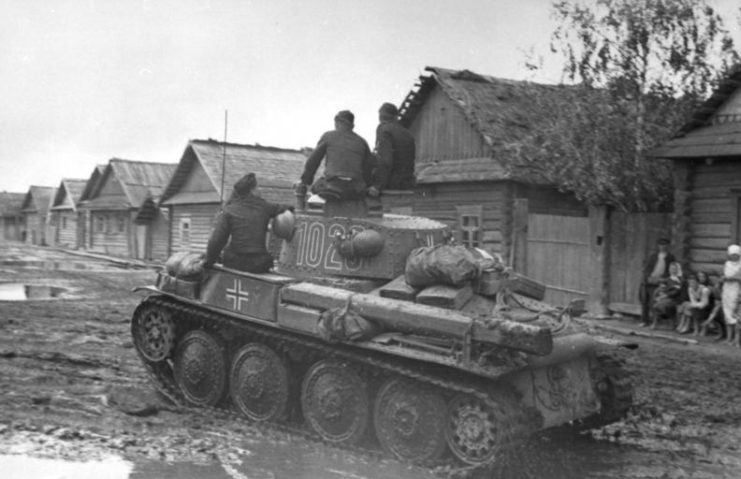
German soldiers in the Soviet Union. (Photo Credit: Bieling / Wikimedia Commons CC BY-SA 3.0 DE)
After Operation Lila, the 7th Panzer Division was stationed between Marseille and Avignon, where it remained until January 1943. With conditions deteriorating on the Eastern Front, they were sent back to the Soviet Union. There, they fought defensive battles as part of Army Group Don and participated in the counterattack on Kharkov.
During the summer of 1943, the division fought in the unsuccessful offensive in Kursk as part of the armored formations of Army Detachment Kempf. They suffered heavy losses. They were then transferred to the XLVIII Panzer Corps, where General Major Hasso von Manteuffel took command.
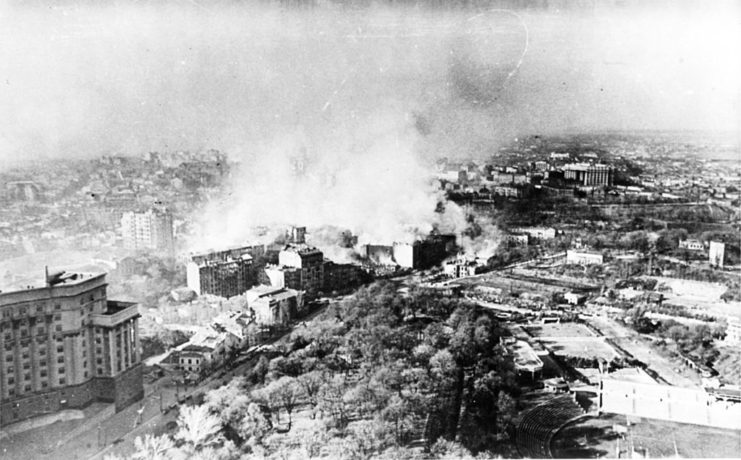
Kiev burning after the German retreat, November 1943. (Photo Credit: Sovfoto / Getty Images)
Two of the last major battles the division fought on the Eastern Front were the Battle of Kiev and the German counterattack at Zhitomir. They also fought in defensive battles during the German Army’s retreat through Ukraine.
The end of the war
Throughout 1944 and 1945, the 7th Panzer Division struggled with its lack of strength, as many of its members were new recruits. They experienced issues during defensive battles along the Eastern Front, two of which resulted in them being evacuated by sea.
Both instances occurred after the division was transferred to the Baltic States to respond to the Soviet Baltic Offensive. In September 1944, Germany’s forces fell back during the Battle of Memel, while in January 1945 they were evacuated from the Hel Peninsula. Both times, they were forced to leave behind heavy equipment.
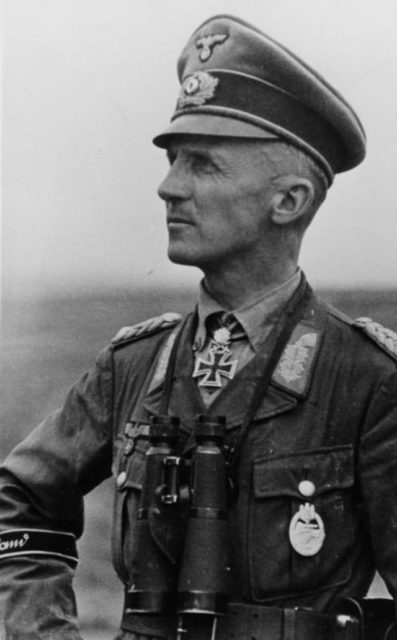
Hasso von Manteuffel. (Photo Credit: Unknown Author / Wikimedia Commons CC BY-SA 3.0 DE)
The end of the 7th Panzer Division came in May 1945. After continuing their defensive fight in northern Germany and Prussia, its surviving members fled into the forest, where they surrendered to the British Army northwest of Berlin.
News
The “Red Zone” – Land Still Abandoned Due to the Dangers Left by the First World War
The “Red Zone” – Land Still Abandoned Due to the Dangers Left by the First World War In the aftermath of the First World War, large areas of northeast France were left in ruin. Years of constant siege warfare along…
Before Becoming a Big-Name Actor, Richard Todd was a Paratrooper Who Fought at Pegasus Bridge
Before Becoming a Big-Name Actor, Richard Todd was a Paratrooper Who Fought at Pegasus Bridge Photo Credit: 1. Sgt. Christie, No. 5 Army Film & Photographic Unit / Imperial War Museums / Wikimedia Commons / Public Domain 2. Silver Screen…
The Potsdam Giants: A Prussian Infantry Regiment Of Nothing But Very Tall Soldiers
The Potsdam Giants: A Prussian Infantry Regiment Of Nothing But Very Tall Soldiers Frederick William I inspecting his giant guards known as The Potsdam Giants, a Prussian infantry regiment No 6, composed of taller-than-average soldiers. Frederick William I of Prussia,…
Ellen DeGeneres cuts a very casual figure as she drives around in her Ferrari
Ellen DeGeneres cuts a very casual figure as she drives around Montecito in her Ferrari… while preparing to embark on her stand-up tour Ellen DeGeneres cut a very casual figure as she made her way around Montecito on Tuesday morning. The…
“I’m heavily tattooed and keep getting rejected for jobs – it’s not fair”
Heavily tattooed OnlyFans star, 23, with multiple piercings on her FACE slams TJ Maxx for rejecting her for a job – accusing retailer of unfairly judging her dramatic look A woman has accused TJ Maxx of rejecting her for a…
All 75 passengers killed in plane crash after pilot let his chirldren control the plane
Praying, turning the engine off by accident and letting KIDS play with the controls: The worst blunders made by pilots before a crash revealed Every time we board a plane, we put our lives in the hands of the pilot….
End of content
No more pages to load





